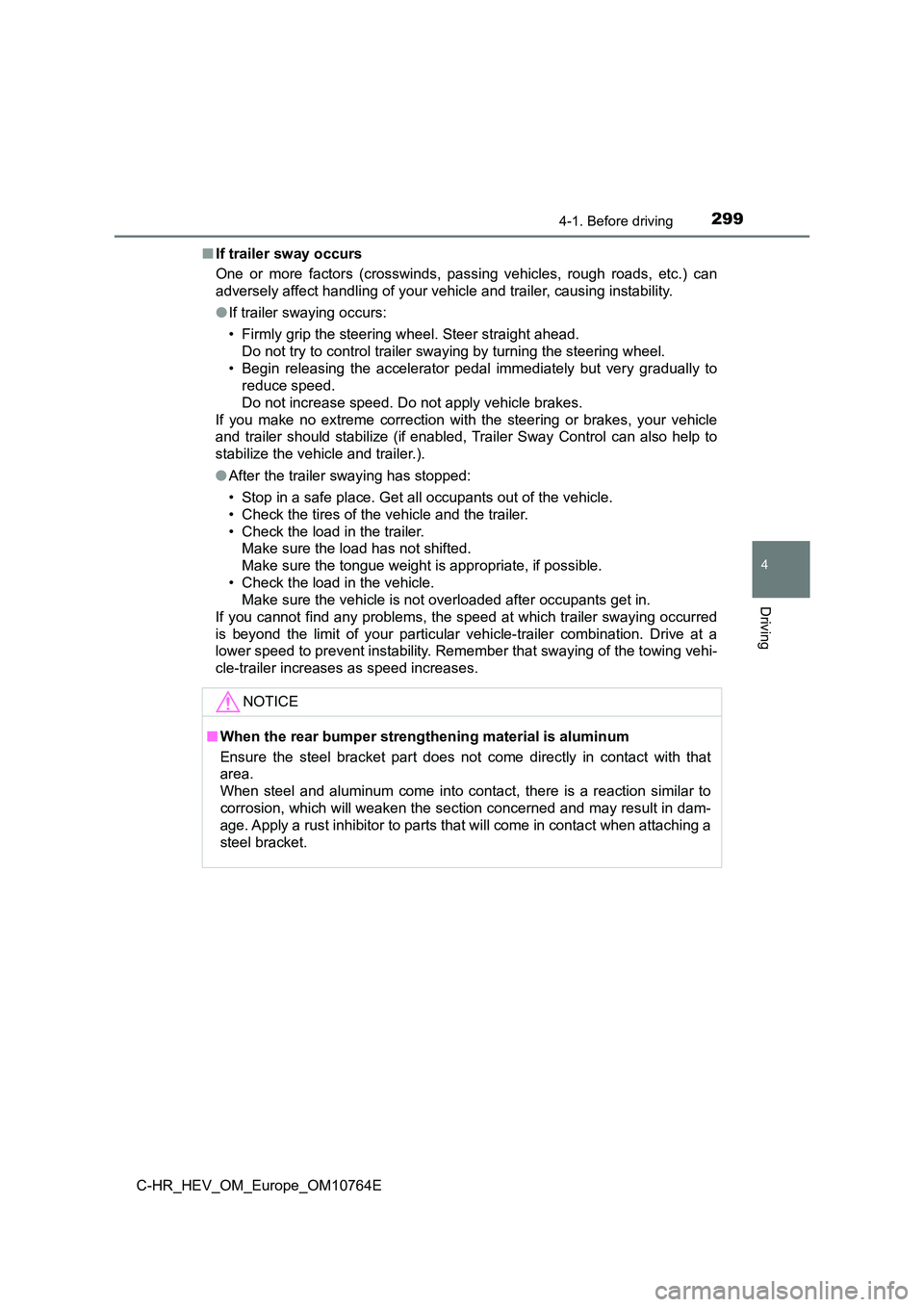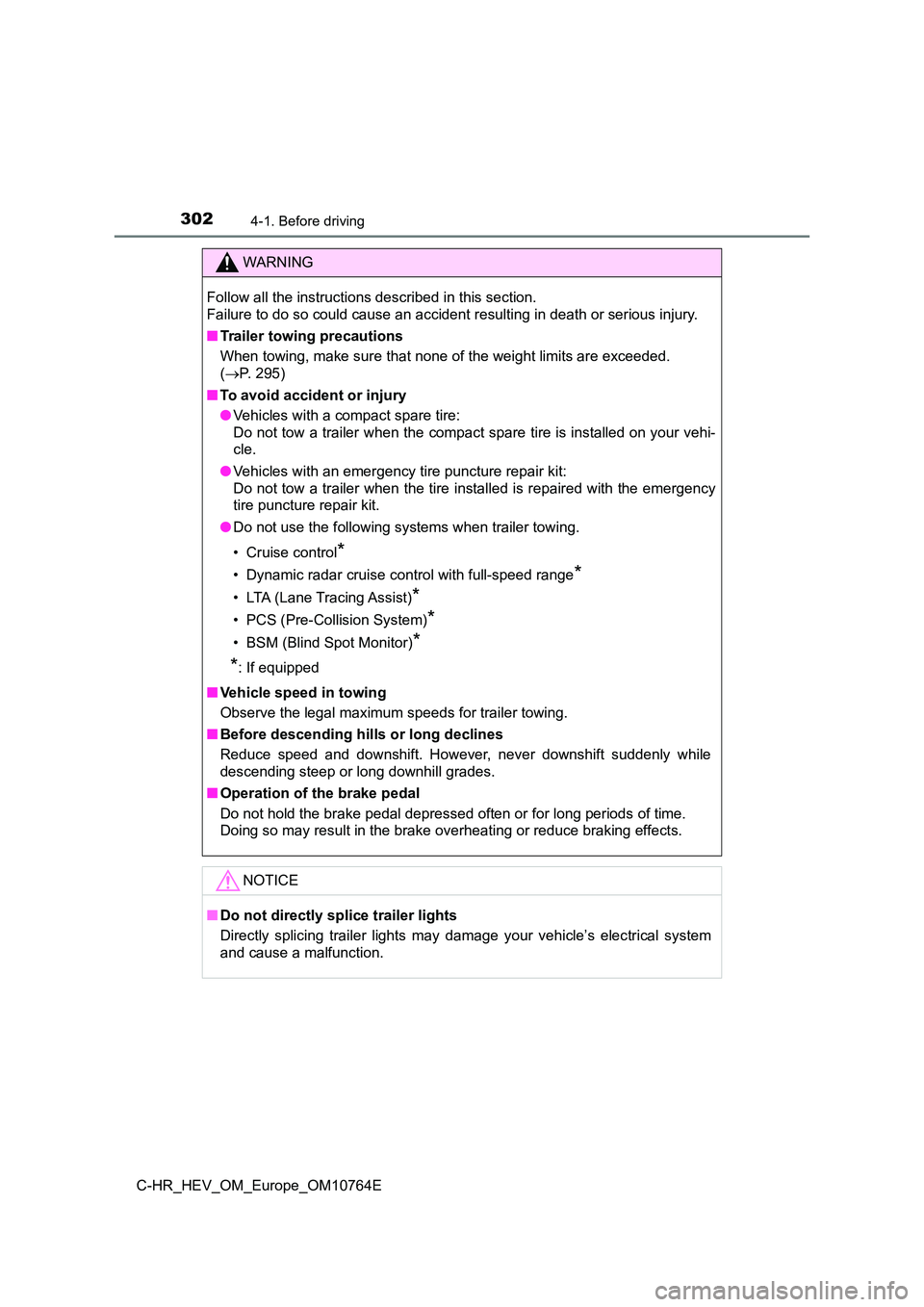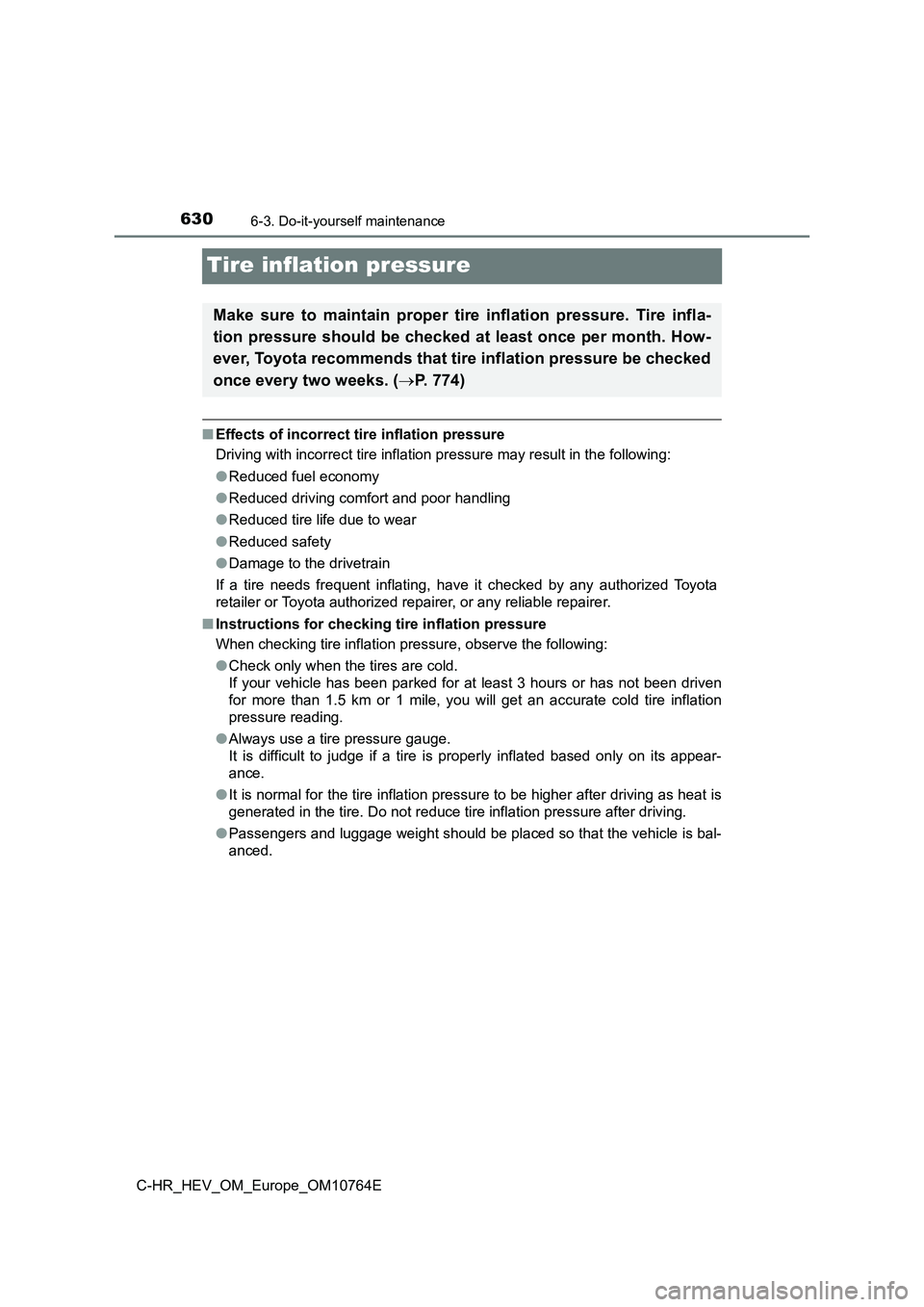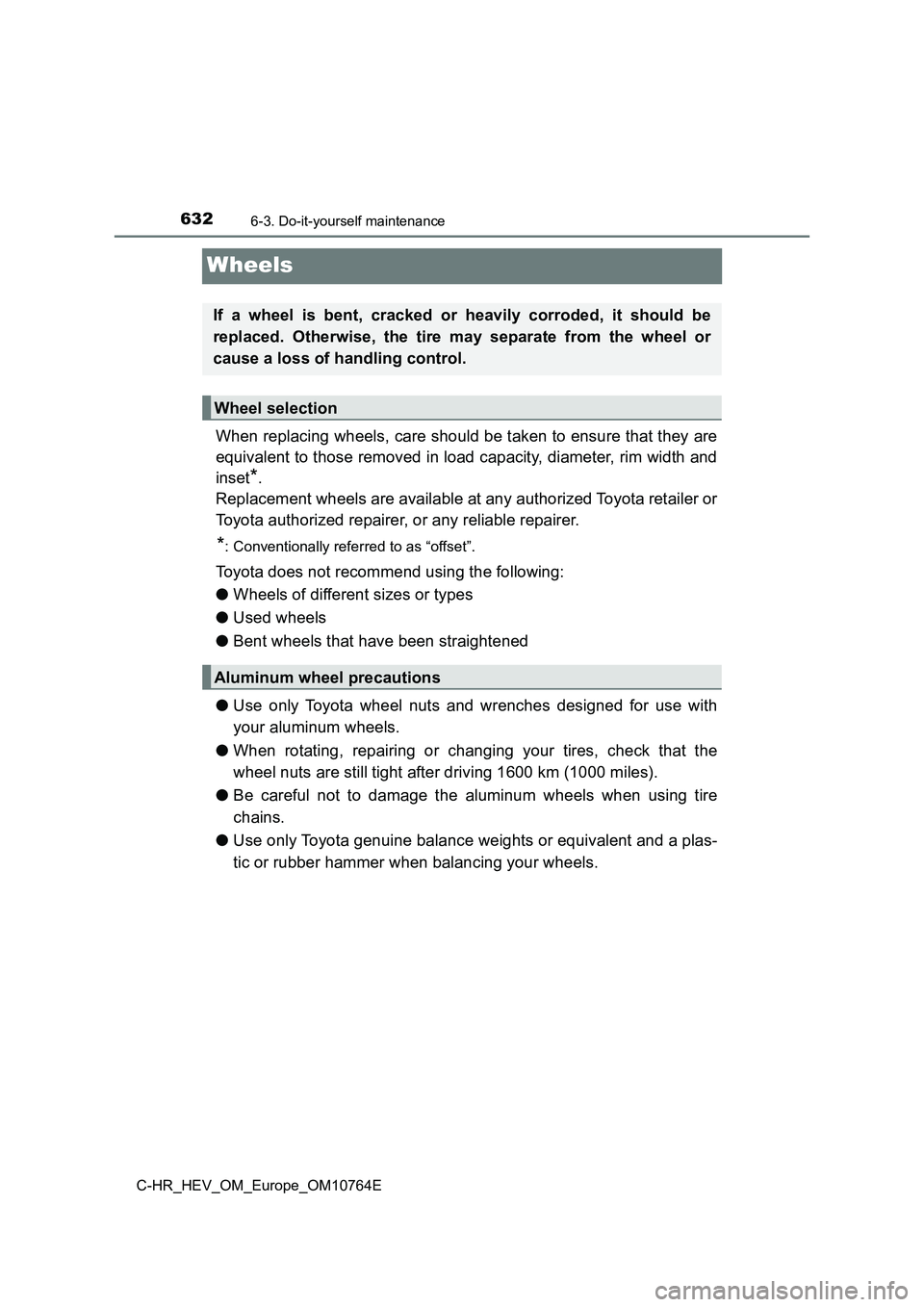Page 301 of 814

2994-1. Before driving
4
Driving
C-HR_HEV_OM_Europe_OM10764E
■ If trailer sway occurs
One or more factors (crosswinds, passing vehicles, rough roads, etc.) can
adversely affect handling of your vehicle and trailer, causing instability.
● If trailer swaying occurs:
• Firmly grip the steering wheel. Steer straight ahead.
Do not try to control trailer swaying by turning the steering w heel.
• Begin releasing the accelerator pedal immediately but very gra dually to
reduce speed.
Do not increase speed. Do not apply vehicle brakes.
If you make no extreme correction with the steering or brakes, your vehicle
and trailer should stabilize (if enabled, Trailer Sway Control can also help to
stabilize the vehicle and trailer.).
● After the trailer swaying has stopped:
• Stop in a safe place. Get all occupants out of the vehicle.
• Check the tires of the vehicle and the trailer.
• Check the load in the trailer.
Make sure the load has not shifted.
Make sure the tongue weight is appropriate, if possible.
• Check the load in the vehicle.
Make sure the vehicle is not overloaded after occupants get in.
If you cannot find any problems, the speed at which trailer swa ying occurred
is beyond the limit of your particular vehicle-trailer combinat ion. Drive at a
lower speed to prevent instability. Remember that swaying of th e towing vehi-
cle-trailer increases as speed increases.
NOTICE
■ When the rear bumper strengthening material is aluminum
Ensure the steel bracket part does not come directly in contact with that
area.
When steel and aluminum come into contact, there is a reaction similar to
corrosion, which will weaken the section concerned and may resu lt in dam-
age. Apply a rust inhibitor to parts that will come in contact when attaching a
steel bracket.
Page 304 of 814

3024-1. Before driving
C-HR_HEV_OM_Europe_OM10764E
WARNING
Follow all the instructions described in this section.
Failure to do so could cause an accident resulting in death or serious injury.
■ Trailer towing precautions
When towing, make sure that none of the weight limits are excee ded.
( P. 295)
■ To avoid accident or injury
● Vehicles with a compact spare tire:
Do not tow a trailer when the compact spare tire is installed o n your vehi-
cle.
● Vehicles with an emergency tire puncture repair kit:
Do not tow a trailer when the tire installed is repaired with t he emergency
tire puncture repair kit.
● Do not use the following systems when trailer towing.
• Cruise control*
• Dynamic radar cruise control with full-speed range*
• LTA (Lane Tracing Assist)*
• PCS (Pre-Collision System)*
• BSM (Blind Spot Monitor)*
*: If equipped
■ Vehicle speed in towing
Observe the legal maximum speeds for trailer towing.
■ Before descending hills or long declines
Reduce speed and downshift. However, never downshift suddenly w hile
descending steep or long downhill grades.
■ Operation of the brake pedal
Do not hold the brake pedal depressed often or for long periods of time.
Doing so may result in the brake overheating or reduce braking effects.
NOTICE
■Do not directly splice trailer lights
Directly splicing trailer lights may damage your vehicle’s elec trical system
and cause a malfunction.
Page 632 of 814

6306-3. Do-it-yourself maintenance
C-HR_HEV_OM_Europe_OM10764E
Tire inflation pressure
■Effects of incorrect tire inflation pressure
Driving with incorrect tire inflation pressure may result in th e following:
● Reduced fuel economy
● Reduced driving comfort and poor handling
● Reduced tire life due to wear
● Reduced safety
● Damage to the drivetrain
If a tire needs frequent inflating, have it checked by any auth orized Toyota
retailer or Toyota authorized repairer, or any reliable repaire r.
■ Instructions for checking tire inflation pressure
When checking tire inflation pressure, observe the following:
● Check only when the tires are cold.
If your vehicle has been parked for at least 3 hours or has not been driven
for more than 1.5 km or 1 mile, you will get an accurate cold t ire inflation
pressure reading.
● Always use a tire pressure gauge.
It is difficult to judge if a tire is properly inflated based o nly on its appear-
ance.
● It is normal for the tire inflation pressure to be higher after driving as heat is
generated in the tire. Do not reduce tire inflation pressure af ter driving.
● Passengers and luggage weight should be placed so that the vehicle is bal-
anced.
Make sure to maintain proper tire inflation pressure. Tire infl a-
tion pressure should be checked at least once per month. How-
ever, Toyota recommends that tire inflation pressure be checked
once every two weeks. ( P. 7 7 4 )
Page 634 of 814

6326-3. Do-it-yourself maintenance
C-HR_HEV_OM_Europe_OM10764E
Wheels
When replacing wheels, care should be taken to ensure that they are
equivalent to those removed in load capacity, diameter, rim wid th and
inset*.
Replacement wheels are available at any authorized Toyota retai ler or
Toyota authorized repairer, or any reliable repairer.
*: Conventionally referred to as “offset”.
Toyota does not recommend using the following:
● Wheels of different sizes or types
● Used wheels
● Bent wheels that have been straightened
● Use only Toyota wheel nuts and wrenches designed for use with
your aluminum wheels.
● When rotating, repairing or changing your tires, check that the
wheel nuts are still tight after driving 1600 km (1000 miles).
● Be careful not to damage the aluminum wheels when using tire
chains.
● Use only Toyota genuine balance weights or equivalent and a plas-
tic or rubber hammer when balancing your wheels.
If a wheel is bent, cracked or heavily corroded, it should be
replaced. Otherwise, the tire may separate from the wheel or
cause a loss of handling control.
Wheel selection
Aluminum wheel precautions
Page 766 of 814
7648-1. Specifications
C-HR_HEV_OM_Europe_OM10764E
Maintenance data (fuel, oil level, etc.)
*1: 2ZR-FXE engine
*2: M20A-FXS engine
*3: Unladen vehicle
*4: Vehicles with 215/60R17 tires
*5: Vehicles with 225/50R18 tires
*6: Except for 2ZR-FXE engine for Guadeloupe, Martinique, F. Guiana and
Svalbard
Dimensions and weights
Overall length4385 mm (172.6 in.)*1
4395 mm (173.0 in.)*2
Overall width1795 mm (70.7 in.)
Overall height*31555 mm (61.2 in.)
Wheelbase2640 mm (103.9 in.)
Tread
Front1550 mm (61.0 in.)*4
1540 mm (60.6 in.)*5
Rear1560 mm (61.4 in.)*4
1550 mm (61.0 in.)*5
Gross vehicle mass1860 kg (4101 lb.)*1
1930 kg (4255 lb.)*2
Maximum permissi-
ble axle capacity
Front1050 kg (2315 lb.)
Rear1080 kg (2381 lb.)
Drawbar load*675 kg (165 lb.)
Towing capacity*6Without brake725 kg (1598 lb.)With brake
Page 793 of 814
7918-3. Initialization
C-HR_HEV_OM_Europe_OM10764E
8
Vehicle specifications
Items to initialize
The following items must be initialized for normal system opera-
tion after such cases as the 12-volt battery being reconnected,
or maintenance being performed on the vehicle:
ItemWhen to initializeReference
Power window• When functioning abnormallyP. 277
S-IPA (Simple Intelligent
Parking Assist System) (if
equipped)
• After reconnecting or chang-
ing the 12-volt batteryP. 517
Tire pressure warning sys-
tem
• When changing the tire size
• When changing the tire infla-
tion pressure by changing
traveling speed or load
weight, etc.
P. 617
PKSB (Parking Support
Brake) (if equipped)
• After reconnecting or chang-
ing the batteryP. 481